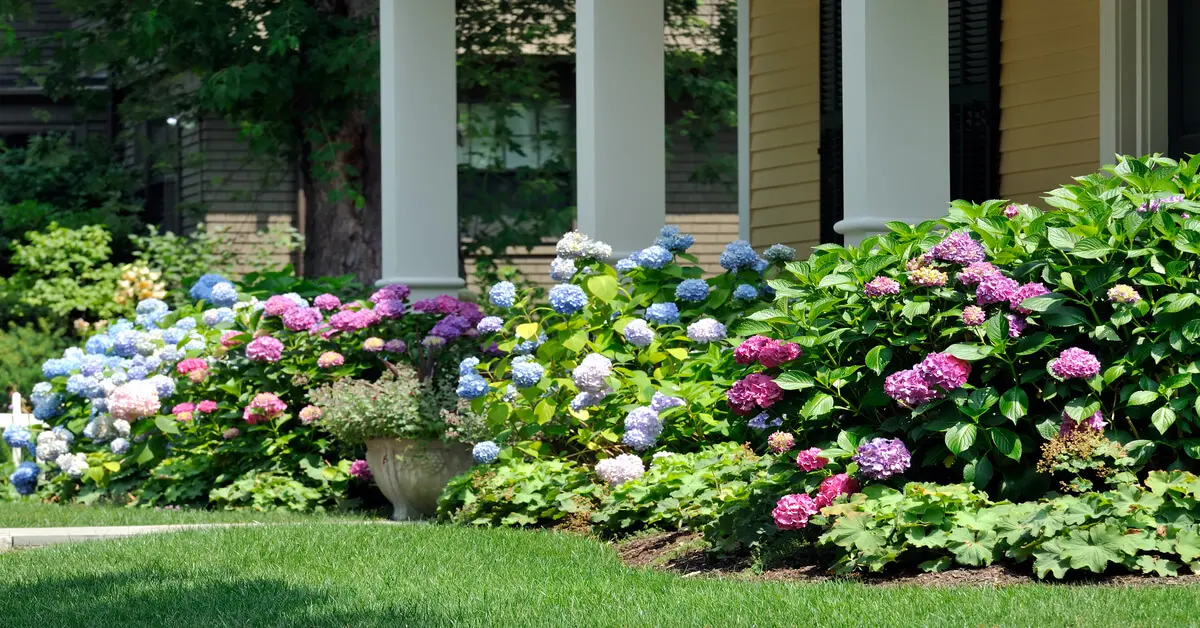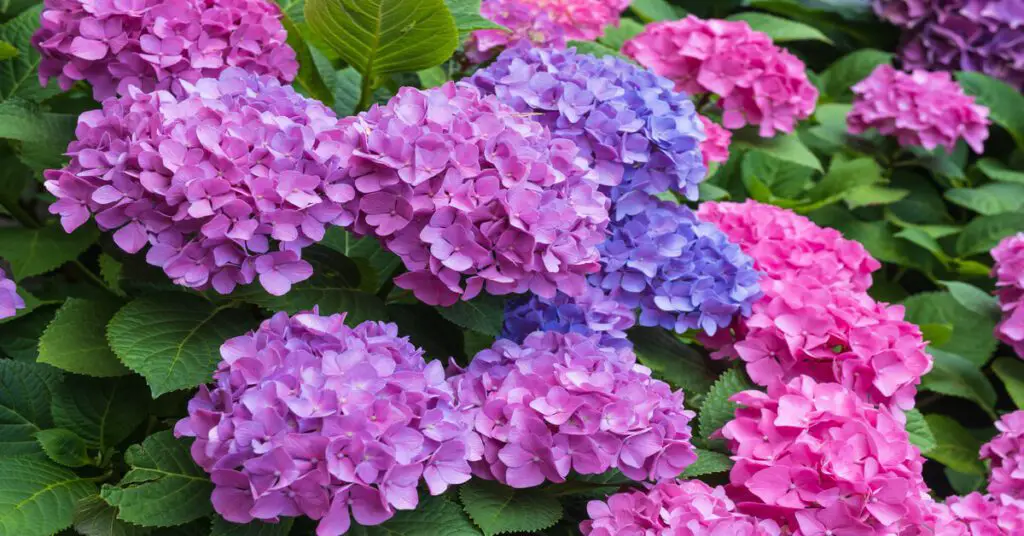Hydrangeas or hortensias originate from various regions of North America, South America, and Asia. The Hydrangea genus comprises over 75 flowering plant species, the most common being Hydrangea macrophylla, also known as bigleaf and French hydrangea.
The common variety of the plant is known for its large cluster of flowers that come in an array of colors, including blue, white, pink, and lilac. The color of the flowers all depends on the pH of the soil.
Hydrangea Care
Hydrangeas make the perfect addition to any garden and have an easy to moderate level of care. With the proper knowledge, you can ensure that your tree or shrub thrives.
Below you will find everything you need to know about Hydrangea care, from soil type to lighting requirements and everything in between!
Soil
The soil for Hydrangea plants should always be free-draining and contain high amounts of organic matter.
Watering
With such large leaves, the plant can require significant amounts of moisture. At a minimum, you should water the bush at least weekly. Although, it will benefit from more frequent watering.
Lighting
For the plant to thrive, they need to receive plenty of morning sun and adequate shade in the afternoon. Hot and exposed areas of your garden could scorch and kill the shrub.
Humidity & Temperature
A Hydrangea bush will thrive in a temperate climate with plenty of moisture. You want to avoid overly hot or dry atmospheres when growing this plant.
Fertilizing
A 10-10-10 general-purpose fertilizer is suitable for a Hydrangea plant. You should apply the fertilizer during the growing season every other month; March, May, and July are best. You will want to use two cups of fertilizer for every 100 sq ft. There is no need to remove mulch when fertilizing; all you need to do is thoroughly water the plant after application to ensure the fertilizer sinks into the soil.
Propagation
If you wish to propagate a Hydrangea bush, you should use the layering method. To use the layering method, you need to dig a trench by the existing plant. Then you bend a limb of the plant into your newly dug trench and use a knife or blade to remove a 1″ ring around the limb. After removing the ring, you can cover the limb with soil, ensuring there is a 6″ to 12″ of tip growth uncovered.
Diseases & Pests
Fungal diseases, such as powdery mildew, anthracnose, and Cercospora leaf spot, can all be issues for Hydrangeas. Better watering practices can help prevent these issues. If you use a sprinkler to water your plants, do so in the morning to give them adequate drying time. Drip irrigation and soaker hoses are the best watering method.
Common pests for the shrub include aphids, rose chafers, and leaf tiers. Insecticidal soap can mitigate these pests.
Pruning
To help encourage old wood development and flowering in the following season, it’s best to prune the plant. Although it is best to stop pruning by August 1st, the dead blooms will protect the shrub through winter.
Bloom time
In the middle of summer, roughly July, and into the fall, blooms will appear on your Hydrangea plant. They thrive in hardiness zones three through seven and sometimes eight and nine.
Types of Hydrangea
There are many Hydrangea macrophylla cultivators, and each cultivator falls into one of two groups.
The first group’s characteristics are sterile flowers that are solid masses, which, in turn, weigh down the stems and make them bend. These are hortensias.
The second group’s characteristics are fertile flowers with some more pronounced than others. Both the pronounced and less pronounced flowers weave together into a pinwheel shape. These are lacecaps.
There are also non-macrophylla hydrangeas that do not fall into either of the categories listed above.
Hortensias
Nikko Blue – These flowers have acidic soil that produces rich blue coloring, and the plant grows between 4′ and 6′.
Compacta – This plant has deeper green leaves than nikko blue and is more compact.
Carmen – These Hydrangeas have large pink blooms and grow to 4′ tall.
Endless Summer – This variety is 3′ to 4′ tall and blooms flower heads over both old wood stems and new wood stem growth.
Lacecaps
Coerulea – This lacecap form of hydrangea has a dark blue center with white and light blue/gray flowers around it. Once mature, the shrub can reach 4′ to 5′ tall.
Blue Wave – The 6′ to 7′ tall shrub typically grows an array of blue-colored lacecap flowers. If they are planted in alkaline soil, the flowers may be pink despite the variety’s name.
Lacecapes can also have silver variegated coloring on their foliage, including Silver Variegated Mariesii and quadricolor.
Other Varieties
Hydrangea arborescens – Commonly known as Snowhill Hydrangea, it has 4″ to 8″ gray-tinted green leaves with dull white flowers. The shrub can grow to 5’ tall.
Grandiflora and Annabelle varieties also fall under this cultivator. The first is a roughly 4′ tall plant with 6″ clusters. The latter is also 4′ tall with 1′ sterile white flower clusters.
Hydrangea paniculata – Commonly known as Peegee Hydrangea, it has white fertile flowers that fade to pink in the fall. The plant can either be a 10′ to 15′ shrub or a 25′ tree. They grow well in seaside locations.
Hydrangea anomala – Commonly known as climbing Hydrangea, this plant has climbing aerial roots, mid-sized roundish leaves, and white lacelet flower clusters.
Hydrangea quercifolia – Commonly known as Oakleaf Hydrangea, the plant gets its name for its 8″ oak-like foliage. The foliage turns copper in the fall and its white flowers age to pink.
There are also harmony and snowflake Hydrangeas that fall under Hydrangea quercifolia. The first is a smaller shrub that reaches 3′ tall and 6′ wide with 1′ sterile flower cones. The latter has large snowflake-like white flower clusters.
Hydrangea serrata – This is a 5′ tall plant, except for its blue billow variety which is 3′. They have leaves and flowers that are slightly on the smaller side.
Planting Hydrangeas

Planting Hydrangeas takes some planning. You will want to know when, where, and how to plant them. Once you have these bases covered, the rest is simple.
The best time of year to plant Hydrangea trees or shrubs is fall. Planting in the fall allows the plant to establish a healthy root system before blooming. If you cannot plant in the fall, early spring is also suitable.
The best location for trees or shrubs is where it can receive sun in the morning and shade in the afternoon. It is best to avoid any overly sunny or dry locations.
And once you have the timing and location right, you can plant your Hydrangeas. To do so, dig a hole roughly 2′ wide and 1′ deep. The root ball should sit level or only slightly above the soil. Finally, cover up the root ball and thoroughly water the plant.
How to change the colors of hydrangea flowers
The color of Hydrangea flowers depends upon the state of the soil. Alkaline soils with a pH over 7.0 produces flowers that have pink and red hues. Acidic soils with a pH below 6.0 produce flowers that are variations of purple and blue.
If you want to lower your soil pH and grow flowers that are purple and blue, you should add garden sulfur or aluminum sulfate.
Growing Hydrangeas in Pots
Hydrangeas can easily grow in pots. When growing this plant in a pot, you need to follow the same care practices as you would when planted in the ground. The only caveat is that you need a pot with proper drainage holes.
Common issues with Hydrangeas
Like any plant, Hydrangea bushes can have their fair share of issues. Some of the most common issues are flowers not blooming, yellowing and brown leaves, and drooping leaves.
If your Hydrangea tree or bush does not bloom during summer or fall, it may have winter injuries. Too much shade, nitrogen, or fertility can also be the cause of the lack of flowers.
Cercospora leaf spot, powdery mildew, and anthracnose can lead to discolored foliage. They are also fungal diseases that can be mitigated through pruning and ensuring your leaves are drying quickly after watering.
Additionally, there are fungicides containing chlorothalonil, thiophanate methyl, mancozeb, or myclobutanil that can control Cercospora leaf spot. Fungicide sprays containing chlorothalonil or thiophanate methyl can mitigate anthracnose. You can treat powdery mildew on Hydrangeas with horticulture oils because they are ornamental plants[1]. The oil should be 1%. You should apply these fungicides every two weeks when treating your plant.
Hydrangea Meaning & Symbolism
Hydrangea flowers symbolize beauty, grace, and gratitude. Their pink, blue, white, and lilac coloring also have meaning and symbolize peace, love, and harmony.
References:
[1]Burgess, C. (2021, February 26). Powdery mildew. Home & Garden Information Center | Clemson University, South Carolina. Retrieved November 3, 2022, from https://hgic.clemson.edu/factsheet/powdery-mildew/

